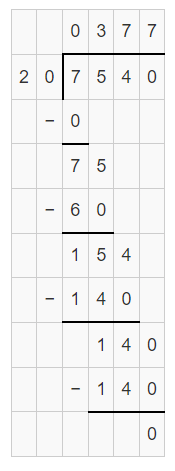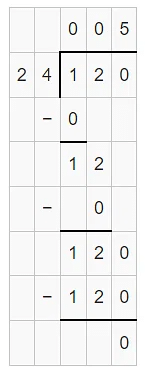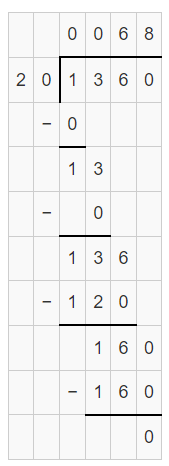Word Problem: Division - 2 | Mathematics for Class 4 PDF Download
Q1: A truck was carrying 340 chairs, staked in sets of 5 chairs each. How many stacks of chairs were there on the truck?
Ans: Total number of chairs = 340
Chairs per stack = 5
The number of Stacks is given by,
Q2: How many hours are there in 1200 minutes?
Ans: To convert minutes to hours, you can use the fact that there are 60 minutes in an hour.
Number of hours =
Number of hours = (1200 / 60)
Therefore, there are 20 hours in 1200 minutes.
Q3: The total train fare for 20 persons is 7540 rupees. What is the fare for 1 person?
Ans: The total train fare = 7540 rupees
Number of persons = 20
Train fare for 1 person = 7540 ÷ 20
Q4: In your classes, you counted 120 hands. How many students were in the class?
Ans: Total number of hands = 120
Number of hands each person has = 2
To find how many students were in the class, we divide the total number of hands by 2.
We get, 120 ÷ 2 = 60
Therefore, there were 60 students in the class.
Q5: A team of 7 construction workers worked together to build 3 sheds in 10 days.How much of a shed did each of them build?
Ans: To find how much of a shed each construction worker built, we can use the concept of "worker-days."
Since 7 workers worked for 10 days to build 3 sheds, the total worker-days can be calculated as:
Total worker-days = Number of workers * Number of days = 7 workers * 10 days = 70 worker-daysNow, since they built 3 sheds in total, each shed required:
Worker-days per shed = Total worker-days / Number of sheds = 70 worker-days / 3 sheds ≈ 23.33 worker-days per shedThis means that, on average, each shed required approximately 23.33 worker-days to be built.
Now, to find out how much of a shed each construction worker built, we divide this value by the number of workers:
Shed built by each worker = Worker-days per shed / Number of workers ≈ 23.33 worker-days per shed / 7 workers ≈ 3.33 worker-days per workerTherefore, on average, each construction worker built about 3.33 worker-days' worth of a shed during the 10-day construction period.
Therefore, each worker built approximately 3 sheds.
Q6: 126 pieces of cookies were equally distributed by Bella among 24 children. How many pieces of cookies did Bella distribute among children if she left with 6 pieces of cookies at the end?
Ans: Total number of cookies = 126
Number of cookies left at the end = 6
Number of cookies consumed = 126 - 6 = 120
Hence number of cookies received by each child = 120 / 24
Q7: 1360 parcel were delivered in 20 days by a courier company. If the company delivered an equal number of packages on all days, how many packages were delivered each day?
Ans: Total number of packages delivered = 1360
Number of days = 20
Packages delivered per day = 1360/20
Q8: A factory produced 9,864 widgets in a day. If they need to pack the widgets into boxes, and each box can hold 48 widgets, how many boxes will be filled completely, and how many widgets will be left over?
Ans: Total number of widgets produced in 1 day = 9864
Number of boxes = 48
Number of widgets in each box = 9864 / 48Therefore, 205 boxes will be filled completely and 24 widgets will be left remaining.
Q9: Sam is building a fence around his rectangular garden. If the perimeter of the garden is 1,398 meters, and one side is 132 meters long, what is the length of the other side?
Ans: We know, the perimeter of a rectangle = 2 x (length + breadth)
Length of one side of the park = 132
Let the length of the other side be y
Therefore, 1398 = 2 x (132 + y)=> 1398 = 264 + 2y
=> 1134 = 2y
Hence y = 1134/2
=> 1398 = 264 x y
=> y = 1398 / 264
Q10: A computer server has 8,497 gigabytes of data that needs to be transferred to external hard drives. If each external hard drive can hold 365 gigabytes, how many hard drives will be filled completely, and how much data will be left to transfer?
Ans: Total amount of data = 8497
Amount of data one drive can hold = 365The server will completely fill 23 external hard drives with 365 gigabytes each, and there will be 102 gigabytes of data left over that can't completely fill another hard drive.
|
33 videos|168 docs|30 tests
|
FAQs on Word Problem: Division - 2 - Mathematics for Class 4
| 1. What is the basic concept of division in mathematics? |  |
| 2. How do you solve a division problem step by step? |  |
| 3. What are some real-life applications of division? |  |
| 4. What is the difference between division with remainders and without remainders? |  |
| 5. How can I practice division to improve my skills? |  |


























